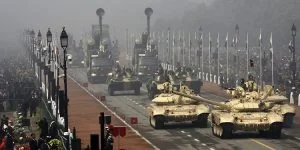
New Delhi: Global military expenditure at 3.6 per cent saw its largest annual spike in a decade in 2019 with China and India being the second- and third-largest spenders after the US, a Stockholm-based think-tank said on Monday, the first time the two Asian giants were among the top three countries spending more on armaments.
The total global military expenditure rose to $1,917 billion in 2019, representing an annual growth of 3.6 per cent compared to 2018, according to a new report by the Stockholm International Peace Research Institute (SIPRI).
The 3.6 per cent spike it said was the largest spending growth since 2010.
While the US drove the global growth, China and India—the top Asian military spenders—were respectively the second- and third-largest military spenders in the world, the report said.
China’s military expenditure reached $261 billion in 2019, a 5.1 per cent increase compared to 2018, while that of India grew by 6.8 per cent to $71.1 billion, it said.
“India’s tensions and rivalry with both Pakistan and China are among the major drivers for its increased military spending,” said Siemon T. Wezeman, SIPRI Senior Researcher.
The total global military expenditure in 2019 represents an increase of 3.6 per cent from 2018 and the largest annual growth in spending since 2010, it said.
The five largest spenders, which accounted for 62 per cent of the total expenditure, were the US, China, India, Russia and Saudi Arabia, the report said, adding that this is the first time that two Asian states have featured among the top three military spenders.
In addition to China and India, Japan ($47.6 billion) and South Korea ($43.9 billion) were the largest military spenders in Asia and Oceania. Military expenditure in the region has risen every year since at least 1989.
The report said that the military spending by the US grew by 5.3 per cent to a total of $732 billion in 2019 and accounted for 38 per cent of global military spending.
The increase in US spending in 2019 alone was equivalent to the entirety of Germany’s military expenditure for that year.
“The recent growth in US military spending is largely based on a perceived return to competition between the great powers,” said Pieter D Wezeman, Senior Researcher at SIPRI.
The global military spending in 2019 represented 2.2 per cent of the global gross domestic product (GDP), which equates to approximately $249 per person.
“Global military expenditure was 7.2 per cent higher in 2019 than it was in 2010, showing a trend that military spending growth has accelerated in recent years,” said Dr Nan Tian, SIPRI Researcher.
“This is the highest level of spending since the 2008 global financial crisis and probably represents a peak in expenditure,” the researcher said.
In Europe, Germany’s military spending rose by 10 per cent in 2019, to $49.3 billion, the largest increase in spending among the top 15 military spenders in 2019.
“The growth in German military spending can partly be explained by the perception of an increased threat from Russia, shared by many North Atlantic Treaty Organization (NATO) member states. At the same time, however, military spending by France and the United Kingdom remained relatively stable,” said Diego Lopes da Silva, Researcher at SIPRI.
In 2019, Russia was the fourth-largest spender in the world and increased its military expenditure by 4.5 per cent to $65.1 billion.
“At 3.9 per cent of its GDP, Russia’s military spending burden was among the highest in Europe in 2019,” said Alexandra Kuimova, Researcher at SIPRI.
The average military spending burden was 1.4 per cent of the GDP for countries in the Americas, 1.6 per cent for Africa, 1.7 per cent for Asia and Oceania and for Europe, and 4.5 per cent for the Middle East (in countries for which data is available).
SIPRI said that data from previous global economic downturns suggests that the economic crisis resulting from the coronavirus pandemic will probably disrupt future military spending.
Follow this link to join our WhatsApp group: Join Now
Be Part of Quality Journalism |
Quality journalism takes a lot of time, money and hard work to produce and despite all the hardships we still do it. Our reporters and editors are working overtime in Kashmir and beyond to cover what you care about, break big stories, and expose injustices that can change lives. Today more people are reading Kashmir Observer than ever, but only a handful are paying while advertising revenues are falling fast. |
| ACT NOW |
| MONTHLY | Rs 100 | |
| YEARLY | Rs 1000 | |
| LIFETIME | Rs 10000 | |










